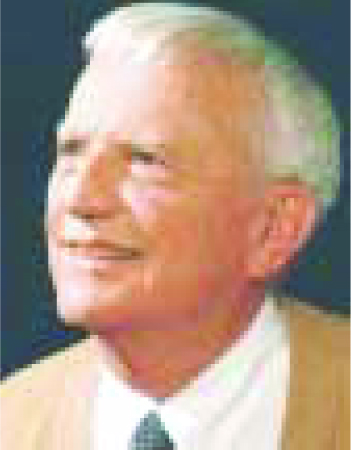AAS Honors Wetherill and Others
DOI: 10.1063/1.1580058
The American Astronomical Society has announced several of its award winners for 2003.
The Henry Norris Russell Lectureship will go to George W. Wetherill, director emeritus of the department of terrestrial magnetism at the Carnegie Institution of Washington. The award citation reads, in part, “One of the truly original thinkers in planetary astronomy, George Wetherill pioneered the application of modern physics and numerical simulations to the formation and evolution of terrestrial planets.” The citation goes on to state that his “geochronology concepts underpin all astronomical radiometric dates. He and his colleagues took the lead in experimental and theoretical studies demonstrating that the meteorites and some Moon rocks are at least as old as the oldest Earth rocks, thereby establishing the first radio-metric chronology for the inner solar system. Through pioneering applications of numerical and analytical simulations, he demonstrated that runaway accretion can account for the assemblage of planetesimals into planets.”
Donat Wentzel, professor emeritus of astronomy at the University of Maryland, College Park, will receive the George Van Biesbroeck Prize for his “outstanding and sustained contributions during three decades to astronomy education in this country by stimulating the American Astronomical Society to become and remain engaged in education, and internationally, through the International Astronomical Union, by guiding the commission on the teaching of astronomy and by working for the growth of astronomy programs in developing countries.”
The Newton Lacy Pierce Prize will go this year to Xiaohui Fan, assistant professor of astronomy at the University of Arizona, in Tucson. Fan is being recognized for his “systematic discovery of high redshift quasars in the Sloan Digital Sky Survey. These quasars are the best probe to date of the epoch of the formation of the first objects in the universe; their discovery enabled identification of the end of the epoch reionization.”
Matias Zaldarriaga has been chosen as the recipient of the Helen B. Warner Prize. An associate professor of astronomy and of physics at Harvard University, Zaldarriaga is being honored for his “incisive, major contributions to the theory of cosmic microwave background (CMB) anisotropies.” The citation adds that he “developed a new method of computing the CMB fluctuation power spectrum, demonstrated that linear polarization anisotropies in the CMB are a cosmological discriminant, and pioneered the study of gravitational lensing effects on the CMB.”
The Joseph Weber Award for Astronomical Instrumentation will be presented to Frank Low, Regents Professor Emeritus at the University of Arizona’s Steward Observatory. Low is recognized for “extraordinary ingenuity in the development of infrared instrumentation and observatories, including bolometers, the Lear Jet and Kuiper Airborne observatories, and the IRAS [Infrared Astronomical Satellite] and SIRTF [Space Infrared Telescope Facility] space missions.”
The AAS Education Prize will go to Jay Pasachoff for his “eloquent and informative writing of textbooks from junior high through college, for his devotion to teaching generations of students, for sharing with the world the joys of observing eclipses, for his many popular books and articles on astronomy, for his intense advocacy on behalf of science education in various forums, [and] for his willingness to go into educational nooks where no astronomer has gone before.” Pasachoff directs the Hopkins Observatory and is the Field Memorial Professor of Astronomy at Williams College in Williamstown, Massachusetts.
The Dannie Heineman Prize for Astrophysics, given jointly by AAS and the American Institute of Physics, will go to Rashid Sunyaev for his “visionary insights into the interaction of radiation and matter on scales from the universe to black holes.” Sunyaev is director of the Max Planck Institute for Astrophysics in Garching, Germany and chief scientist at the Space Research Institute of the Russian Academy of Sciences in Moscow.
Robert Duncan, Christopher Thompson, and Chryssa Kouveliotou will share the Bruno Rossi Prize, given by the high-energy astrophysics division of AAS, for Duncan and Thompson’s prediction of, and Kouveliotou’s observational confirmation of, “the existence of magnetars, neutron stars with extraordinarily strong magnetic fields.” Duncan is a research scientist in astrophysics at the University of Texas at Austin. Thompson is an associate professor at the Canadian Institute for Theoretical Astrophysics in Toronto. Kouveliotou is a senior research scientist with the Universities Space Research Association on detail at NASA’s Marshall Space Flight Center in Huntsville, Alabama.
Robert Howard will receive the 2003 George Ellery Hale Prize from AAS’s solar physics division. He is being honored for his “pioneering discoveries of fundamental properties of solar magnetic and velocity fields; initiating modern instrumentation and archiving methods for long-term solar observations; and selfless mentoring, collaboration, and leadership of solar physics research programs and institutions.” Howard, now retired, was the first director of the National Solar Observatory.
The solar physics division also announced the winner of the first Karen Harvey Prize, which is given for significant contributions to the study of the Sun early in a person’s professional career. Dana Longcope, associate professor of physics at Montana State University, is being recognized with this prize for his “contributions to the study of the Sun’s magnetism in the areas of separator reconnection and flux-tube physics.”
AAS’s division for planetary sciences has announced that Robin Canup is the winner of the 2003 Harold C. Urey Prize. Canup, assistant director of the space studies department at Southwest Research Institute in San Antonio, Texas, will receive the prize for her “groundbreaking research contributions on the Moon’s origin and dynamical evolution.”


